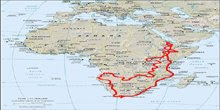
The view from the Bale Mountain National Park headquarters at Dinsho
The Bale Mountains are situated about 8 hours drive south of Addis Ababa. They are the second highest range in Ethiopia with a highest elevation at around 4,200m. They are home to a number of endemic species, some of which we were fortunate enough to see during our stay: the Ethiopian wolf, the Mountain Nyala, the Abyssinia Catbird, the Abyssinian Ciskin, the Blue Winged Goose, the Wattled Ibis, the Rouget’s Rail, and the Spot-breasted Lapwing.
We hired a mandatory guide (US$12 per day) and two horse assistants (US$5 per day) and their horses (US$3.50) for the six day trek. Our guide Ahmed, only 21 years old, was exceptionally knowledgeable on the fauna and flora and very professional in his approach. Our two horse assistants, Mohammed and Jamal, would walk ahead each day with the horses and welcome us with a hot come of tea when we arrived at each camp. In the evening we would all share a campfire together.

Our horses with Mohammed and Jamal

Ahmed, our guide.
We saw eight Ethiopian wolves over the six days, the rarest canine in the world. Apparently almost 80% of the population in this region died in a rabies epidemic earlier this year. Fortunately conservationist managed to curb the epidemic by inoculating the remaining population.

Our first sighting of an Ethiopian Wolf
 A Giant Lobelia
A Giant Lobelia
Our third camp at Raku
 The view over Black Lake from Camp 4
The view over Black Lake from Camp 4 Time for a shave?
Time for a shave?
The going was very gentle but the distances quite long, 18 to 22km per day. After 3 months of sitting in the car, it took us a few days to find our rhythm. There are a few herders living seasonally within the park, but mostly it is deserted and we only saw one other group of hikers, on our last day. We thoroughly enjoyed our experience and would recommend it over the Simien Mountains, which we visited a few weeks later.
 Our last campsite
Our last campsite Caro and Black Lake
Caro and Black Lake Lunch at a lake on the Sinyati Plateau
Lunch at a lake on the Sinyati Plateau A frosty morning at Raku Camp
A frosty morning at Raku Camp A herder's house on the plateau
A herder's house on the plateau
Relaxing after a day's walk
Even if you are not planning a trek we would still recommend a visit to the park headquarters at Dinsho, and the high plateau. The park headquarters are located on a forested hill, remnants of the original vegetation. And if the beautiful trees aren’t enough of a reason for you to visit, the abundant wildlife living on the Dinsho Hill should be. The warthogs, Colobus monkeys, jackals, nyalas and other antilope, are numerous and not shy at all: a peaceful 30 minutes walk around the Dinsho Hill guarantees close range sightings.

A female Mountain Nyala

A Black-and-White Colobus Monkey

A young seasonal resident in the park
Sunrise over the Giant Lobelias
Ethiopian coffee??







No comments:
Post a Comment